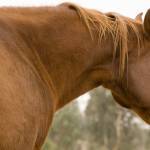Abdominal Obstructions in Horses

Enteroliths receive the most attention as causes of intestinal tract obstruction. However, there are other, less frequently encountered obstructions that lead to the same clinical signs and appearance.
Usually, enteroliths and the obstructions discussed in this article occlude the large intestine when they become lodged in its lumen (the inside of the gut) and act as a ball-valve, preventing passage of intestinal contents. Obstruction causes intestinal distension, pain, and clinical signs of colic. Depending where they are situated in the intestine, these obstructions will roll back into an area of the intestine larger in diameter, and they will cause chronic colic until they eventually have to be removed surgically.
Fecaliths are dry concretions of manure. These are seen most often in the late fall and winter when forages are coarse and horses may drink less water. Fecaliths are a common cause of small colon impactions in American Miniature Horses.
Phytoconglobates are concretions of matted plant material that form into balls.
Trichobezoars and phytobezoars are combinations of hair (trichobezoar) or plant material (phytobezoar) that mineralize and harden with magnesium ammonium phosphate. Persimmons can cause gastric impaction in horses and humans because persimmons can gel and form phytobezoars in the acidic environment of the stomach.
Dental abnormalities, poor-quality forages, and decreased water intake are believed to predispose horses to phytoconglobates, trichobezoars, and phytobezoars. Foals may be apt to develop intestinal obstructions because they are more inquisitive and likely to eat foreign materials. Intestinal obstruction due to eating a foreign body is reported to be more likely in horses less than three years old.








